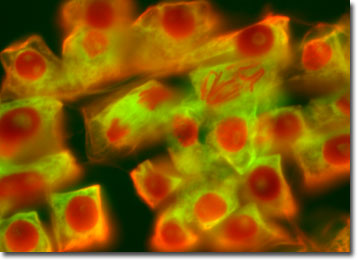Fluorescence Digital Image Gallery
Fava Bean Root Tip Mitosis
The fava bean plant (Vicia faba), also known as broad bean or horse bean, is a legume belonging to the pea family, Fabaceae. It is cultivated for its seeds, six to eight beans resembling large round limas, packed inside a large, pale-green, velvety pod.

As with lima beans, the pods are edible only when they are very young and immature. As a rule, the pods are discarded. Fava plants are cultivated as a vegetable and used green or dried, fresh or canned, and for stock feed. Roasted beans are eaten like peanuts in India.
Fava beans have been an important crop in the Mediterranean area and Asia since the late Neolithic period, about 3,000 BC. During the Bronze Age, around 1,500 BC, the plant was distributed north of the Alps, where it represented one of the most important food plants until the beginning of modern times. Today, it has achieved a wide distribution throughout the temperate regions of the world and is one of the most important winter crops for human consumption in the Middle East.
For some people of Mediterranean, African, or Asian heritage (primarily males), fava plants can be lethal. Favism, a hereditary deficiency of the enzyme Glucose-6-Phosphate Dehydrogenase (G6PD), can cause a severe allergic reaction to ingestion of the fava bean or inhalation of its pollen. Affected individuals can experience hemolytic anemia, fever, jaundice, or even death. During the Korean War, doctors made the connection between G6PD and the hemolytic effects of anti-malarial drugs. The favism-inducing toxins are believed to be divicine and isouramil, the aglycone moieties of vicine and convicine. Favism is the most common human enzyme deficiency.
The specimen presented here was imaged with a Nikon Eclipse E600 microscope operating with fluorite and/or apochromatic objectives and vertical illuminator equipped with a mercury arc lamp. Specimens were illuminated through Nikon dichromatic filter blocks containing interference filters and a dichroic mirror and imaged with standard epi-fluorescence techniques. Specific filters for the fava bean root tip tissue stained thin section were a B-2E/C and a Y-2E/C. Photomicrographs were captured with an Optronics MagnaFire digital camera system coupled to the microscope with a lens-free C-mount adapter.
BACK TO THE FLUORESCENCE DIGITAL IMAGE GALLERY
